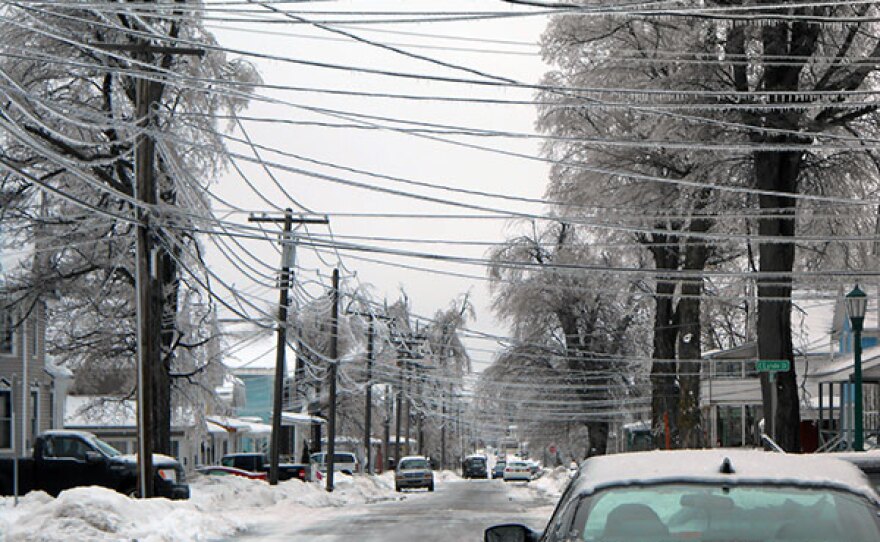Updated at 3:40 p.m.
At a news conference at 2 p.m. this afternoon, Jefferson County emergency officials said that all streets in Watertown are now open, but they are advising residents to "use extreme caution" while driving, especially around work crews. Earlier, there was a "no unnecessary travel advisory" for Jefferson County. While no more extreme weather is expected, temperatures are turning colder tonight. Joe Plummer, Jefferson County's director of fire and emergency management said that residents should watch for falling ice and use safety precautions around generators.
National Grid spokeswoman Melanie Littlejohn said at the 2 p.m. news conference that more than 10,000 customers were still without power. But, they expect to have power restored to 90 percent of customers by tomorrow (Tuesday). There are 1,600 workers out restoring power currently -- including workers from New Jersey, New York City, and the Ohio River Valley.
The ice storm hit towns by Lake Ontario the hardest -- including Sackets Harbor, Alexandria Bay, Cape Vincent and Clayton.
From earlier:
Today is supposed to bring the last of the ice storm that’s snapped branches and downed power lines all over the north country. Tens of thousands have lost power, including about 60 percent of customers in Jefferson County, which saw the brunt of the ice.
With the power out and much of the city closed down, Travis MacCue was doing all there was to do Sunday afternoon in Watertown: check out the destruction. He didn’t have to go far.
“I’m looking at an 80-foot tree, with about 20, 30 limbs down, two power lines broke. I’m surprised this man didn’t lose his front porch,” he said, from the sidewalk across the street from his house. His neighbor’s porch was spared, but his roof had an icy branch dangling above it.
He said his night was noisy.
“You could keep hearing branches breaking off and coming down and hitting the side of the house. One branch hit so bad here – such a big one – it knocked all my pictures right off the wall of my house,” MacCue said.
Last night, shelters set up throughout the county took in those without heat and people who needed to power medical devices.
Bob Simpson, the deputy fire coordinator for Jefferson County, is managing the emergency response center during the storm. He said communities along the Lake Ontario shoreline have been hit hardest, with the highest concentration of tree damage and power outages.
He said the county has been working with National Grid to identify priorities for restoring power. One of them was River Hospital. “Most of the other medical facilities, while they may have been on generator power, it wasn’t for an extended period of time like it was in Alexandria Bay,” he said. “So the goal was to get them up and running again.”
This storm is the first test of the county’s special emergency center since the notorious 1998 ice storm. Simpson said many responders who helped the county make it through that disaster are back this time around – using what they learned. In one big, way, he said, the response is different now.
“One of the things we’re doing new this time is social media, with Facebook and Twitter, to get information out to the public,” he said. The Facebook page garnered over 100,000 hits in 24 hours. Simpson says pushing information out that way helps answer people’s questions – and clears out phone lines for real emergency calls.










